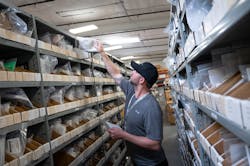It was a storyline for much of last year that has continued into this year – supply chain strains. With experience now under their belts, parts suppliers and MROs are getting used to the shifting supply chain landscape and keeping parts on hand. The difficult part now is not so much just rolling with the punches, but learning where they’ll strike.
Predicting demand is the most challenging aspect of the parts game today, said John Kochel, director of parts & logistics, Western Aircraft – Boise, Idaho.
“OEMs and independent MROs all face this challenge, and taking an informed look at history is sometimes the best indicator. We take time to pay special attention to problem parts and where we need to increase stock levels due to availability or repair and overhaul turn time. Utilizing software like CAMP for maintenance tracking is another area we look to for future forecasting, but that approach is still in the preliminary stages when it comes to our purchasing decisions,” he said.
Kochel added that most of their parts are kept with a min-max level to ensure they are being prompted to reorder before something runs out.
“However, we also analyze usage with manual processes to ensure we are updating our target inventory levels and recognizing new parts that may be moving we had not previously set target levels for,” he continued.
Staying Ahead
Ben Funston, vice president of supply chain execution, Boeing Global Services, said supply chain disruption post-COVID has been much deeper, broader, and enduring than previous shocks – something that is not unique to the aerospace industry.
“The suddenness at which demand stopped, then restarted has created a timing and imbalance between supply and demand,” he said.
The shifts in the supply chain have led to a shift in the way parts are being kept up with across the industry.
Funston said they’ve shifted way from a purchasing approach based on lead time, to a time-phased purchasing approach that increased buffer stock and time that suppliers must ensure for on-time delivery of orders.
“We also matured our Sales Inventory & Operations Planning process to incorporate improved customer requirements, planning and forecasting to better align demand and supply,” Funston said.
He adds that Boeing leverages its enterprise capability and presence to address supply chain constraints and support suppliers.
“We’ve increased onsite presence at suppliers, expanded our digital inventory tracking tools, created teams of experts to manage work movement and address common industry-wide shortages, ramped up internal fabrication for surge capacity and increased inventory of select parts and components for risk protection. With safety and quality at the forefront, we are prioritizing stability and predictability every step of the way,” Funston continued.
Kevin Lenz, senior vice president for powerplants at AvAir, said they rely on customer/partner input as well as data analysis to identify what material to repair, minimum stock levels, etc., based on their customers’ fleet and product focus.
“We rely on demand cues from our partners and customers as well as our transaction data as part of greater overall inventory management. There will also be disruptions that are unforeseen until they materialize but we strive to address the disruption patterns in a proactive manner. The patterns we’ve seen in the last few years include longer turnaround time at repair, higher scrap rates, higher repair costs, combined with end users unable to wait the longer lead times for material receipt,” Lenz said.
For Western Aircraft, Kochel said these days they’re managing a much larger backlog with their suppliers and in some cases have orders placed for over a year out into the future for substantial volume.
“There are always a few ‘one-off’ parts every few months that end up creating a serious challenge because they need to be manufactured and there are continued delays. Effective communication and follow-up are essential in those situations and sometimes there is frustration on all sides,” Kochel said.
Disruptions Continues
Though perhaps less frequent today, as Kochel notes, disruptions are still on going.
“There have been problems areas since 2020, that have been consistent. PPG windshields have been an ongoing problem and generally, companies with production in states that experienced longer shutdowns and provided more and more financial incentives to remain unemployed have been the places we have seen the slowest recovery. And, in some cases, we have had to change vendors to maintain our turn times,” he said.
Lenz says that not only is the greater global supply chain still in flux, but labor challenges across the board are adding to the headaches.
“I see a need for continued adjustments and adaptation to what is the ‘new normal’ in this space,” Lenz said. “The biggest one that comes to mind is that organizations need to focus on a pipeline of human capital to build a labor force that is skilled and sophisticated to help get in front of future market volatility. AvAir is proud in its retention throughout the last few years; in fact we’ve added many team members over this time. A big focus for us is to continually hire and develop new talent and promote from within whenever possible.”
At Boeing, Funston said they’re making strides to drive stability through their supply chain. Though he adds that constraints continue and he anticipates it will take time for the entire supply chain to return to stability.
“The supply chain architecture in the aerospace industry is fragile to industrial, geopolitical and exogenous shocks. To ensure supply can meet demand, a supply chain risk management process is needed that expands beyond the Tier 1 suppliers and addresses business continuity risks with the sub-tier suppliers and raw material sources. Additionally, inventory management must consider disruption scenario capacity constraints, and cold start lead times for recovery planning.
“We will continue to actively mitigate risks to ensure we can meet our commitments,” Funston said.
Staying Ready
With the solution to these issues still some ways off in the future, and operations learning to adapt to the shifting supply chain tide, Funston recommends keeping the following in mind for managing inventories.
- Putting an emphasis on forecast and demand/supply planning in close alignment with the customer.
- Providing greater visibility of anticipated end-user demand to all tiers of the supply chain early and often.
- Supporting early supplier investment by placing longer term time-phased orders.
- Ensuring business continuity of the supply chain must become a risk management capability of any supply chain function.
- Collaborating with suppliers openly and transparently so potential disruptions are identified early to implement proactive contingency mitigation plans.
To their benefit, Western Aircraft has also moved to more locally sourced items when possible.
“Moving away from large corporations when possible and into smaller more customer-focused businesses has provided some relief in the supply chain, this is true for rotables and consumables. Locally we are trying to be smart and stock the right parts, which has led us to pull back support for certain airframes and focus on others where we have more control of our customer outcomes,” Kochel said.
Lenz shares similar sentiments, advocating for companies to take proactive measures and avoid staying still for too long. “My suggestion would be to be diligent and consistent with both customer/partner engagement as well as data analysis to position the company as proactive as possible. Stagnation today is the enemy of production tomorrow,” he said.
In all, Kochel said there is little substitute these days for the hard work needed to stay ready and have parts on hand.
“For those companies looking to create more stability for parts, there is no substitute for hard work. Get out to trade shows and meet new companies, analyze your data to understand trends and reach out to the OEMs you support to see if they can help you see the bigger picture when it comes to data. Most importantly hire great people who want to fix problems and are tenacious when it comes to finding ways to improve performance for our customers,” he said.
About the Author
Walker Jaroch
Editor
Contact: Walker Jaroch
Editor | AMT
+1-920-568-8399
>> To download the AviationPros media kits, visit: Marketing Resource Center
>>Check out our aviation magazines: Ground Support Worldwide | Airport Business | Aircraft Maintenance Technology

